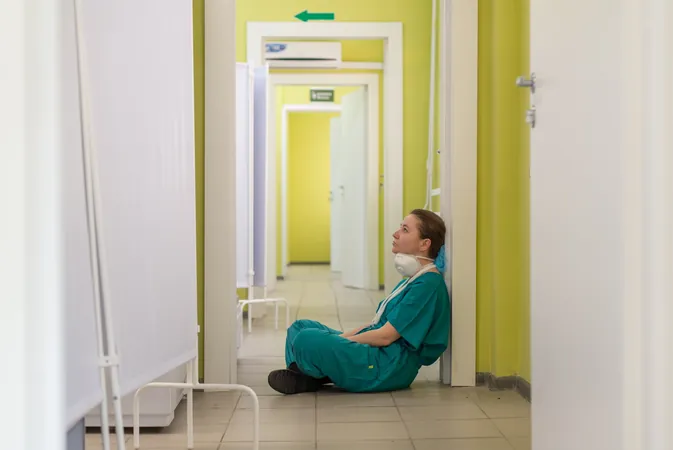
Revolutionizing GPP Treatment: Spesolimab's Game-Changing Potential Unveiled
2024-12-18
Author: Yu
The Heavy Burden of GPP Flares
GPP is often regarded as a medical emergency in dermatology, with patients living in constant fear of impending flares. Dr. Aaron Farberg, chief medical officer at Bare Dermatology, described these episodes as traumatic experiences that can induce anxiety and lead to severe systemic symptoms. He expressed concern over the psychological toll, stating, "It’s a traumatic, dramatic experience... a very impactful flare can be extremely scary and worrisome for these patients."
Physically, GPP flares are associated with pain and malaise, severely degrading patients’ quality of life. Many patients describe a sensation of being constitutionally unwell, leaving them feeling helpless against the unpredictability of their condition.
The Challenges of Treatment
Managing GPP has been notoriously difficult, primarily due to the lack of reliable biomarkers for flare prediction. Treatments typically involve trial and error with various biologics, resulting in unpredictable outcomes. Farberg likened the previous treatment landscape to the "Wild West," illustrating the desperate need for targeted therapies before the advent of spesolimab.
Introducing Spesolimab
Initially provided in an intravenous formulation for acute GPP flares, recent studies have shifted focus to a subcutaneous formulation aimed at flare prevention. Clinical evidence supports the rapid efficacy of spesolimab, with many patients achieving resolution from pustules within just 7 days of treatment.
A Groundbreaking Study: Key Insights
A monumental multinational clinical trial investigated the efficacy of spesolimab in preventing GPP flares over an extended duration. The study included participants aged 12 to 75 years, all with documented histories of at least two past GPP flares.
**Eligibility Requirements:** - At least two previous documented GPP flares. - Minimal disease activity represented by a Physician Global Assessment score of 0 or 1 at screening. - A washout period from any preceding GPP treatments before randomization.
Patients received various loading and maintenance doses of spesolimab during the study, with some placed in a placebo group. Those facing a flare were administered an intravenous dose of the medication.
**Study End Points and Outcomes:** The primary objective focused on the time until the first GPP flare within 48 weeks, with secondary measures evaluating the occurrence of at least one flare within that time frame. Farberg noted the study’s straightforward nature regarding its primary endpoint: "How soon were you going to flare?"
Study Strengths and Limitations
The study is recognized for its ethical design and relevance to real-world applications but does have limitations. While sufficient for such a rare disease, the sample size could benefit from being larger for more conclusive results. Additionally, management variability among investigators regarding treatment after flares introduces subjectivity that could affect the outcomes.
Safety Profile and Considerations
Ensuring patient safety is paramount, and the adverse event profile for spesolimab provided reassuring insights, with no significant new safety concerns emerging compared to placebo. Farberg noted no hypersensitivity reactions; however, some slight increases in infections and injection site reactions were observed, which are typical in treatment populations.
Dr. Bruce Strober highlighted the importance of caution when interpreting safety data, especially from smaller study populations, and urged continuous monitoring for potential infections given GPP's severity.
Clinical Implications
Interestingly, some patients experienced pustular psoriasis as an adverse event, which may indicate a manifestation of the disease rather than a treatment effect. This complexity in managing GPP, particularly for patients with comorbid conditions, underscores the ongoing necessity for careful observation and evaluation of responses to spesolimab.
Moving forward, understanding GPP's natural history and conducting post-approval safety studies will be crucial for interpreting clinical outcomes in diverse patient populations and making informed decisions about the use of spesolimab.
Conclusion: A Potential Breakthrough for GPP Patients
The innovative approach offered by spesolimab could represent a transformative leap forward in the management of generalized pustular psoriasis, providing hope to patients long suffering from this debilitating condition. As further studies unfold, the dermatology community eagerly anticipates the potential for improved treatment modalities to enhance the quality of life for GPP patients worldwide.




 Brasil (PT)
Brasil (PT)
 Canada (EN)
Canada (EN)
 Chile (ES)
Chile (ES)
 España (ES)
España (ES)
 France (FR)
France (FR)
 Hong Kong (EN)
Hong Kong (EN)
 Italia (IT)
Italia (IT)
 日本 (JA)
日本 (JA)
 Magyarország (HU)
Magyarország (HU)
 Norge (NO)
Norge (NO)
 Polska (PL)
Polska (PL)
 Schweiz (DE)
Schweiz (DE)
 Singapore (EN)
Singapore (EN)
 Sverige (SV)
Sverige (SV)
 Suomi (FI)
Suomi (FI)
 Türkiye (TR)
Türkiye (TR)